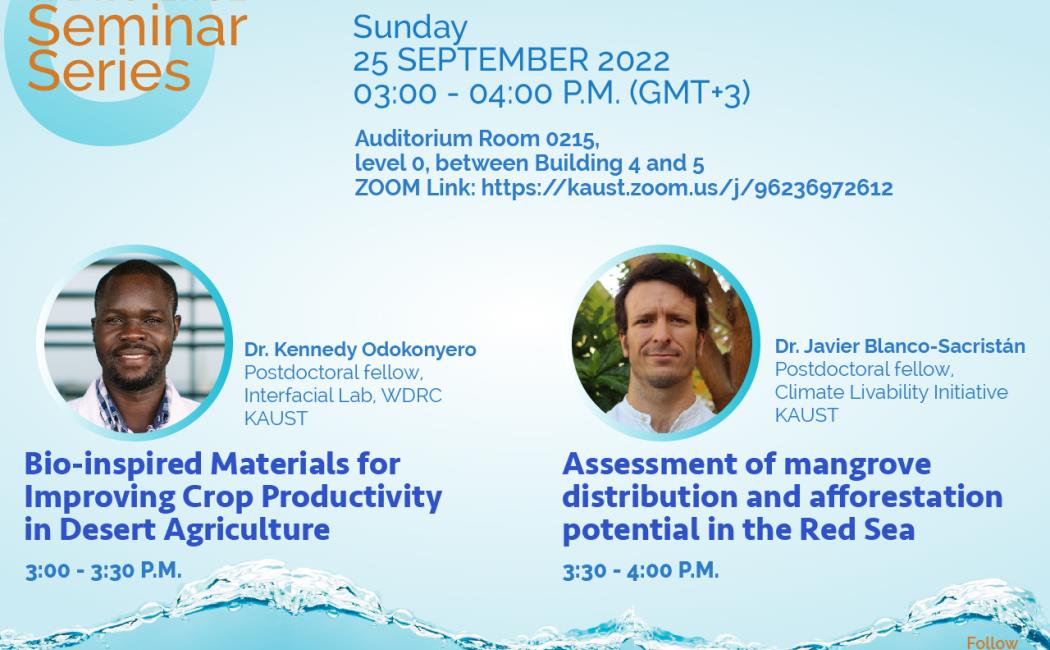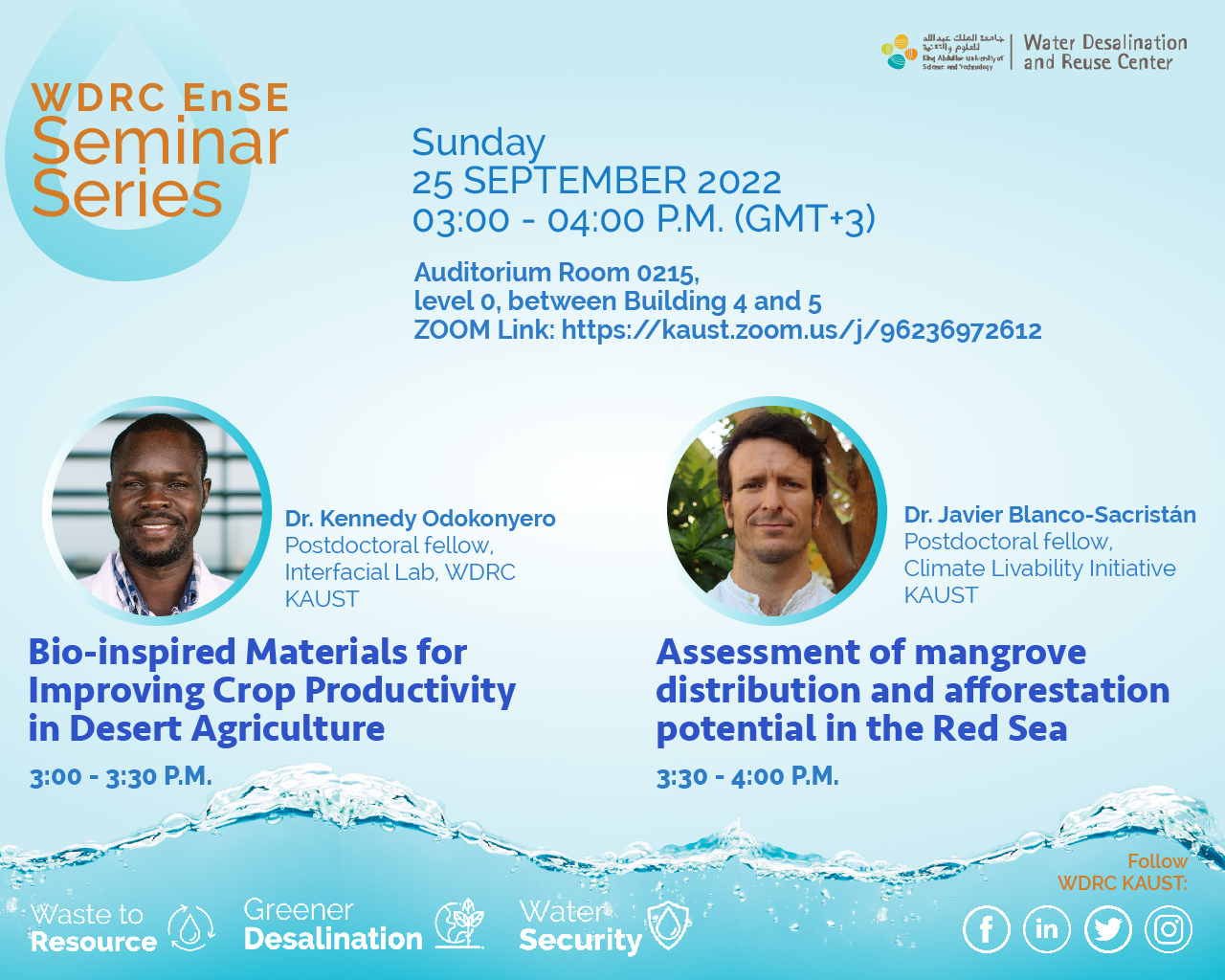



Venue: Auditorium 0215, level 0, between Bldg. 4&5
By Dr. Kennedy Odokonyero, Postdoctoral fellow, Interfacial Lab, WDRC, KAUST | 3:00 - 3:30 p.m. (GMT +3)
Abstract:
In regions with arid and semi-arid climates, irrigated agriculture is a crucial facilitator of food-water security. Due to high temperatures and dry winds in these regions, excessive evaporative loss of water from the topsoil is inevitable. The nutrient-deficient desert sandy soils are also prone to substantial percolation, which exacerbates water stress thereby hindering crop productivity. To compensate for this, gigascale freshwater withdrawals are the only resort, which are simply unsustainable. Therefore, sustainable precision agriculture technologies are needed to dramatically enhance the efficiencies of water and nutrient utilization and improve productivity in arid regions. To address these complex challenges, our group has pioneered two bio-inspired soil amendment technologies: (i) Superhydrophobic sand (SandX) and (ii) enriched biochar. I will present the results of our multiyear experimental studies under controlled environmental conditions as well as field-scale trials under normal and reduced irrigation scenarios. Spectators will gain mechanistic insights into the workings of our tech portfolio, i.e., how it improves irrigation efficiencies and crop yields under harsh arid conditions.
Bio:
Kennedy Odokonyero earned his Ph.D. in Agricultural Science from the University of Tasmania in Australia and an MS in Agro-environmental Management from Aarhus University in Denmark. During his Ph.D., he worked at the International Center for Tropical Agriculture (CIAT) in Colombia and held a Visiting Research Scientist position at the Biosciences Eastern and Central Africa-International Livestock Research Institute (BeCA-ILRI) in Nairobi, Kenya. His research focused on tuning plant-microbial interactions via environmental stresses for crop yield enhancement. In 2018, Kennedy joined Prof. Himanshu Mishra’s team as a Postdoc Fellow. Since then, he has hybridized his plant science training with iLab’s expertise in bio-inspired materials engineering and contributed to fundamental and translational research on the effects of SandX and biochar and their combinations on plant health under varying irrigation scenarios. He co-invented wax-coated jute bags technology to combat post-harvest losses in developing countries.
By Dr. Javier Blanco Sacristan, Postdoctoral fellow, Climate Livability Initiative, KAUST | 3:30 - 4:00 p.m. (GMT +3)
Abstract:
Mangrove ecosystems represent one of the most effective natural environments for fixing and storing carbon (C). Mangroves also offer significant co-benefits, serving as nurseries for marine species, providing nutrients and food to support marine ecosystems, and stabilizing coastlines from erosion and extreme events. Given these considerations, mangrove afforestation and associated C sequestration have gained considerable attention as a nature-based solution to climate adaptation (e.g., protect against more frequent storm surges) and mitigation (e.g., offsetting other C-producing activities). To advance our understanding and description of these important ecosystems, we leverage Landsat-8 and Sentinel-2 satellite data to provide a current assessment of mangrove extent within the Red Sea region and also explore the effect of spatial resolution on mapping accuracy. We establish that Sentinel-2 provides a more precise spatial record of extent and subsequently use these data together with maximum entropy (MaxEnt) modeling approach to: i) map the distribution of Red Sea mangrove systems and ii) identify potential areas for future afforestation. From these current and potential mangrove distribution maps, we then estimate the carbon sequestration rate for the Red Sea (as well as for each bordering country) using a meta-analysis of sequestration values surveyed from the available literature. For the mangrove classification, we obtained mapping accuracies of 98 %, with a total Red Sea mangrove extent estimated at approximately 175 km2. Based on the MaxEnt approach, which used soil physical and environmental variables to identify the key factors limiting mangrove growth and distribution, an area of nearly 410 km2 was identified for potential mangrove afforestation expansion. The factors constraining the potential distribution of mangroves were related to soil physical properties, likely reflecting the low sediment load and limited nutrient input of the Red Sea. The current rate of carbon sequestration was calculated as 1034.09 ± 180.53 Mg C yr−1, and the potential sequestration rate as 2424.49 ± 423.26 Mg C yr−1. While our results confirm the maintenance of a positive trend in mangrove growth over the last few decades, they also provide the upper bounds on above ground carbon sequestration potential for the Red Sea mangroves.
Bio:
Javier Blanco-Sacristán is currently a postdoctoral fellow at KAUST. He worked as postdoctoral researcher at the University of Exeter. Blanco-Sacristan obtained his Ph.D. on Environmental Science at the University of Milano-Bicocca and his MsC in Conservation and Management of Biodiversity and BsC on Biology at the University of Granada, Spain.